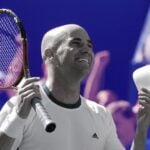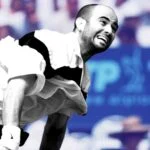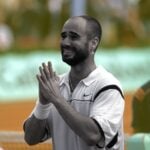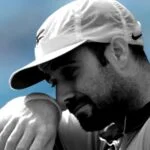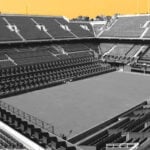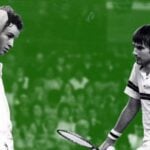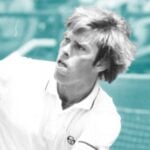May 24, 2004: The day Andre Agassi lost to a French qualifier in the first round at Roland-Garros
Every day, Tennis Majors takes you back in time to relive a tennis event which happened on this specific day. On May 24, 2004, Andre Agassi suffered the worst loss of his career in a Grand Slam tournament since his Roland-Garros debut in 1987
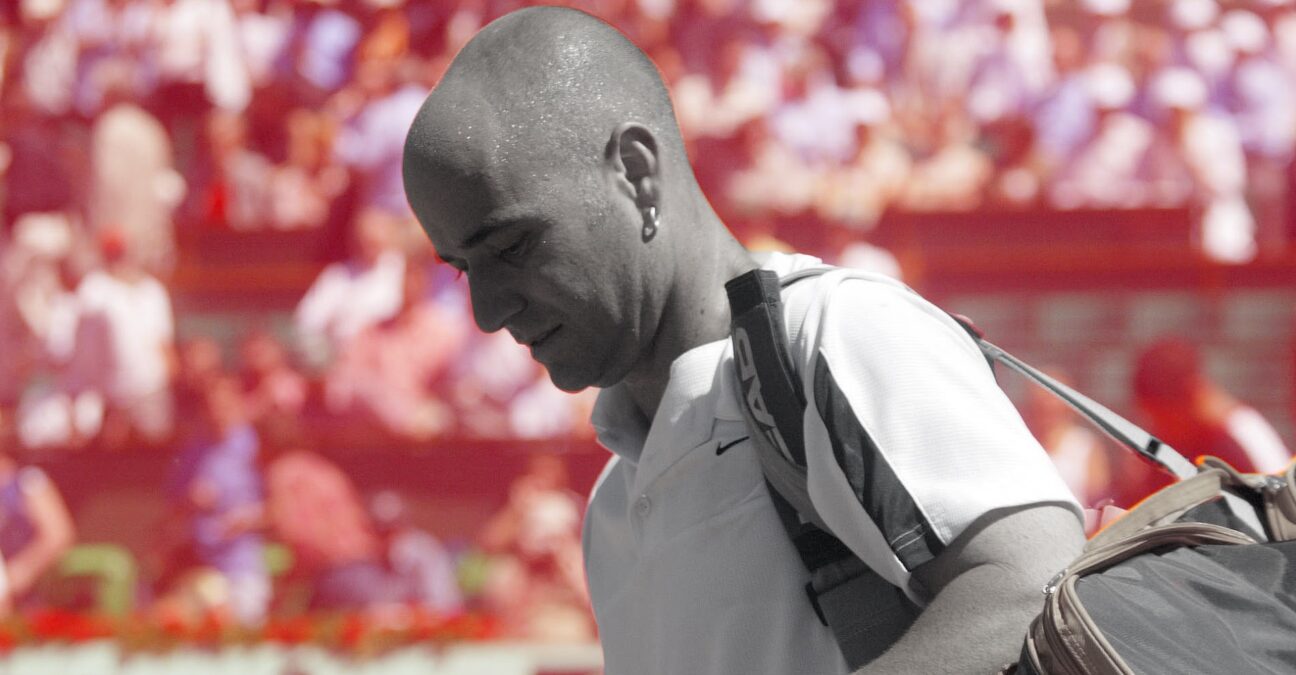 Andre Agassi
Andre Agassi
What exactly happened on that day?
On this day, May 24, 2004, 1999 champion Andre Agassi lost in the first round of Roland-Garros against French qualifier Jerome Haehnel, ranked No 271 in the world. Although it was known at the time that the 34-year-old American was struggling with injuries, it was still the worst loss of his career in a Grand Slam tournament since his Roland-Garros debut in 1987 where he suffered a second-round defeat against Patrice Kuchna, then ranked No 325.
The players : Andre Agassi and Jerome Haenel
• Andre Agassi: The eight-time Grand Slam champion
Andre Agassi, the Las Vegas Kid, born in 1970, was a tennis legend. He had turned professional in 1986 and soon became one of the game’s biggest superstars, thanks to his incredible tennis skills and also his eye-catching outfits, including the iconic denim shorts and the pink bicycle shorts that he wore underneath.
Taught by his father and then based at the Nick Bollettieri Academy, Agassi’s game relied on a great return (the best of its time) and on hitting the ball on the rise off both flanks with incredible power, which was revolutionary at the time and then copied by generations of players. After finishing runner-up three times, once at the 1990 US Open and twice at Roland-Garros (1990 and 1991), the American claimed his first Grand Slam title at Wimbledon in 1992, defeating the big-serving Goran Ivanisevic in the final (6-7, 6-4, 6-4, 1-6, 6-4).
This title was followed by the 1994 US Open and 1995 Australian Open, the only time he beat his long-time rival, Pete Sampras, in a Grand Slam final (4-6, 6-1, 7-6, 6-4). Agassi became world No 1 shortly after this success, on April 10, 1995, for 30 weeks.
In 1996 and 1997, despite winning a gold medal at the 1996 Olympic Games in Atlanta, Agassi went through a very difficult time and his ranking dropped as low as No 141. Displaying great humility, he went back to play on the ATP Challenger tour at the end of 1997 to regain his confidence. He worked his way back to the top in 1998 and finished the year as world No 6, although his Grand Slam results were disappointing.
In 1999, he finally triumphed at Roland-Garros, eight years after his second runner-up finish, following a dramatic final where he came back from two-sets-to-love down to beat Russian Andrei Medvedev (1-6, 2-6, 6-4, 6-3, 6-4). That year, after finishing runner-up to Sampras at Wimbledon (6-3, 6-4, 7-5), Agassi captured a second US Open title and regained the world No 1 ranking for another 52 weeks. In the following years, he added three more Australian Open titles to his career achievements (2000, 2001, 2003) and appeared at the top of the ATP rankings one last time on September 7, 2003. Ranked sixth at the start of Roland-Garros in 2004, the American began the season by losing an incredible five-set semi-final at the Australian Open against Marat Safin (7-6, 7-6, 5-7, 1-6, 6-3), followed it with another semi-final appearance at Indian Wells, where he lost to the new world No 1 Roger Federer, (4-6, 6-3, 6-4). At 34, the legend was still not done.
- Jerome Haehnel: The flight-phobic Frenchman
Frenchman Jerome Haehnel was born in 1981 and turned pro in 1998. Mostly used to competing on the ITF Futures and ATP Challenger circuits, Haehnel had never played in the main draw of a Grand Slam event prior to Roland-Garros in 2004. Suffering from a phobia of flying, which was particularly inconvenient for a tennis player, he played only in Europe where he could travel by train or car. He was ranked No 271 at the time, not far from his best ranking of No 248, which he reached in September 2001. His last tournament before the Roland-Garros qualifying event was an ITF Futures event in Neheim-Husten, Germany, where he lost in the first round to world No 855 Andis Juska, from Latvia.
The place: Stade Roland-Garros
This story unfolded at Roland-Garros, Paris. The stadium, located in the west of Paris at the edge of the Bois de Boulogne forest, had been hosting the French Grand Slam since 1928. It was the first and now only Grand Slam to be played on clay, the slowest surface, which made it the hardest tournament to win from a physical standpoint. Its Centre Court, renamed in 2001 after the former president of the French Tennis Federation, Philippe Chatrier, had a capacity of 15,000. It was also the location of the National Tennis Centre, where the best professional and junior players from all over France were practicing. Haehnel, as a part of the elite program in his youth, had been living a few yards away from Roland-Garros for years and knew the stadium by heart.
Agassi had played his first Roland-Garros in 1987 and the French crowd had seen the evolution of the Las Vegas Kid, first known for his looks and his outfits, grow into a world-class champion.
The facts: Agassi goes down in straight sets
When Agassi arrived in Paris in May 2004, it was no mystery that Roland-Garros was not on top of his priority list. The 1999 champion was now 34 and clay was too demanding on his body, especially as he had been recently suffering from back pain. In fact, despite a good start to the year on hard courts, Agassi had only participated in one tournament on red dirt, in Sankt Polten, where he lost to doubles specialist Nenad Zimonjic, then ranked No 339 (6-2, 7-6). Nonetheless, he had a great record at Roland-Garros and even in the last three last years, he had reached the quarter-finals each time. So even if he had clearly prioritised hard courts over clay, the French crowd expected Agassi to win his first round.
On this particular Monday, the legend faced French qualifier Haehnel, not the easiest of experiences for someone who was facing his childhood idol on a packed 15,000-seater Centre Court.
“When I found out I was to play Agassi, I was disappointed, as he was the only seeded player I wanted to avoid. He was older, clever and he was my idol. I was really tense for two days but it allowed me to prepare for the match, to visualise anything that could happen”, Haehnel said years later in an interview with tennisleader.fr.
Meanwhile, the Las Vegas Kid was not moving very well, not hitting the ball as hard as expected and soon began to get irritated. The focused Frenchman quickly took the lead and playing far better than his ranking would have suggested, he defeated his favourite player in straight sets, 6-4, 7-6, 6-3. For the first time since the 1998 Roland-Garros Championships, Agassi did not get past the first round at a Grand Slam tournament. In his press conference, he said he was not sure whether he would play in Paris the following year. In fact, he would, only to be defeated in the first round again, this time by Finland’s Jarkko Nieminen.
What next? Haehnel peaks at No 78 in the rankings while Agassi reaches another Grand Slam final in 2005
Haehnel would lose in the next round against compatriot Michael Llodra (6-3, 6-2, 3-6, 6-1). In October the same year, he would claim his first and only ATP title in Metz beating a 19-year old Stan Wawrinka in the final round of qualifying and a young Richard Gasquet, then ranked No 154, in the final (7-6, 6-4) to make 2004 his best season. He reached his best ATP ranking of No 78 in February 2005.
Agassi would pull out of Wimbledon, which would trigger rumours about a possible retirement. He would shut down those rumours by claiming the Masters 1000 crown (his last Masters title) in Cincinnati, defeating Lleyton Hewitt in the final, 6-3, 3-6, 6-2, and by reaching the quarter-finals at the US Open, where he lost a five-set thriller to world No 1 Roger Federer (6-3, 2-6, 7-5, 3-6 6-3).
In 2005, aged 35, he would reach the final at the Canadian Open (losing to Rafael Nadal, 6-3, 4-6, 6-2) and his last Grand Slam final a few weeks later in New York, where he was once again defeated by Federer (6-3, 2-6, 7-6, 6-1). Only in 2006 would Agassi exit the top 10 for good. Playing in only eight tournaments, he would officially end his career at Flushing Meadows. After delivering a last epic fight to prevail against world No 8 Marcos Baghdatis (6-4, 6-4, 3-6, 5-7, 7-5) in the second round, he would be defeated by Germany’s Benjamin Becker in the third round, 7-5, 6-7, 6-4, 7-5.


